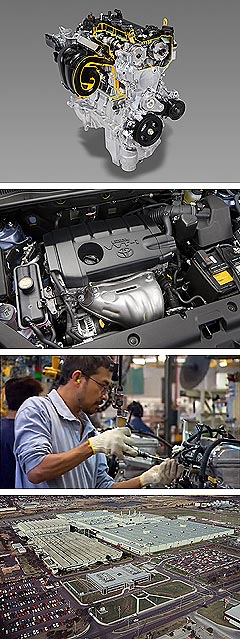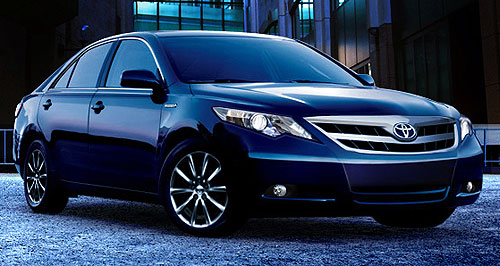Make / Model Search
Future models - Toyota - CamryToyota Camry shapes upNew face: An artist's impression of the next-generation Toyota Camry, based on Japanese sketches.(Digital image: Luc Britten) Imported engines to power all-new Camry while Toyota rebuilds engine plant17 May 2011 TOYOTA Australia will import four-cylinder engines from Japan for up to a year for its crucial new-generation Camry as it completes its massive $331 million engine plant rejuvenation in Victoria. The new Camry engine plant, partly funded by a $63 million federal Green Car Innovation Fund grant, will not ramp up to full speed until October 2012 – about 12 months after the new seventh-generation Camry is due to start rolling down the Altona production line. The company says the new model remains on track for a fourth-quarter launch this year, although Toyota planners appear not to have ruled out an early 2012 debut if the timing gets tight around Christmas. The Camry Hybrid variant, which again will be built alongside the standard petrol range, is expected to follow several months later, with the new V6 Aurion – based on the new Camry – arriving in the second quarter. The Altona assembly plant has been running on half shifts since May 9 due to a shortage of parts in the wake of the Japanese earthquake in March, but is set to resume normal production of the current Camry and Aurion on June 6 at the rate of about 9000 units a month. In the meantime, Toyota is putting the finishing touches to its redesigned models, which have been designed overseas for global markets, but with local product-planning and engineering input. Sketches surfacing in Japan indicate the new-generation Camry will get a bolder face in a relatively conservative makeover that appears evolutionary rather than revolutionary.  From top: Toyota AR 2.5-litre four-cylinder engine, Altona production line, Altona plant overhead shot. From top: Toyota AR 2.5-litre four-cylinder engine, Altona production line, Altona plant overhead shot.The images indicate a heavier grille and sharper headlight treatment for the all-important volume-selling Camry that will be tasked with retaining Toyota’s mid-size car crown against a raft of newcomers such as General Motors’ Malibu. Over the past week, Hyundai has also revealed its all-new i40 medium-sized sedan, which is under consideration for release in Australia to form a two-pronged attack – with the i45 – against the Camry. VFACTS figures show Camry sales are down 18.6 per cent year to date, although it still holds a commanding 32.8 per cent share of the mid-sized car market, well ahead of the Ford Mondeo (13.3 per cent), Mazda6 (10.6), Subaru Liberty (9.1), Honda Accord Euro (8.2) and the i45 (7.8). Last year, Toyota sold just over 25,000 Camrys for a 40.2 per cent share of the medium-car market segment. The new ‘AR’ 2.5-litre four-cylinder engine – including an Atkinson-cycle variant for the Camry Hybrid – is not scheduled to go into full production locally until late 2012, meaning Toyota Australia will have to carry a heavy import bill for drivetrains initially. Work on the 100,000-unit a year engine plant is due to start in August this year, with the so-called commissioning stage running from late January to March. But the plant is not scheduled to ramp up to full speed until October 2012, with Toyota’s official project overview pamphlet saying the factory will conduct low-volume engine production trials to finetune the new engine production line until the end of September 2012. Toyota Australia has this week confirmed to GoAuto that more than 300 engine plant employees will be redeployed into other areas of the Altona factory for several months while the new production machinery is installed – a process that will require excavation for new foundations for some machines. Although the local engines will not arrive until 2012, production of the new Camry using the same AR four-cylinder engines from Japan will start late this year for local launch in either December or January. The hybrid version will go into production a few months later, with the new V6 Aurion next in line from about April. The new engines to be built at Altona will be the same AR powerplants that will be imported from Japan to fill the production gap once the all-new Camry model – the seventh generation in Australia – starts rolling down the Altona production line late this year. The 2.5-litre AR replaces the 2.4-litre AZ engine in the local Camry, although the newer engine has done duty in the American version since 2009. In the US, the engine comes in two states of tune – a 126kW/226Nm for base models and a 133kW/230Nm version for the Camry SE. This compares with 117kW/218Nm for the current engine in the Australian Camry. Toyota says fuel consumption will improve by 4.5 per cent, cutting the current Camry combined fuel consumption from 8.8 litres per 100km to about 8.5L/100km. CO2 emissions are also expected to be cut by about five per cent, from 208 grams per kilometre to below 200g/km. The Camry is expected to get a six-speed automatic transmission – up from the current five-speed – while the hybrid will continue to match its petrol-electric second-generation Hybrid Synergy Drive drivetrain with a continuously variable transmission (CVT). The current Camry Hybrid combines a 110kW petrol engine – which is imported – with a 30kW electric motor for a combined output of 140kW. Ultimately, the 2.5-litre petrol engine for the new Hybrid Camry will be made alongside the standard engine at Altona, while the remainder of the hybrid powertrain will continue to be imported. The engine plant was the subject of much debate within Toyota until last year, when the federal government, Victorian government and Toyota Australia convinced TMC to invest in a much-needed revamp for the plant. The alternative for Toyota was to make the four-cylinder engines in Thailand and ship them to Australia. Now, Toyota Australia will export some of the engines to Thailand and Vietnam, as well as continuing to export completely built up Camrys to the Middle East. Announcing the intention of the company to return to normal production levels in June, Toyota Australia president and CEO Max Yasuda said last week that the company had confirmed it had sufficient parts to support a return to full vehicle production. “Toyota Australia and our suppliers have worked closely with Toyota Motor Corporation to secure the parts needed to resume normal vehicle production levels in early June,” Mr Yasuda said. “This has involved studying and confirming the supply of critical parts from the earthquake-affected areas and identifying interim alternate suppliers. “Mr Yasuda praised the efforts of the Toyota Australia family in helping the company to resume full production earlier than anticipated. “The past two months have been challenging for Toyota Australia employees, dealers and suppliers, but their flexibility and support has been critical in helping the company get back on its feet quickly,” he said.  Read more10th of March 2011  Toyota creates new ‘global vision’No threat to Aus operations as Toyota sets out new mid-term business plan19th of October 2010  Toyota Camry locked and loaded for 2011Standard Camry to lead new model roll-out next year, with hybrid to follow in 201210th of September 2010  Green light for $300 million Toyota engine plantNext Camry locked in for Australia as Toyota signs off on new engine factory5th of August 2010  Toyota set to go local on hybrid partsCamry Hybrid to get more local content as Toyota gears up for 2012 modelAll future models Alfa Romeo Alfa Romeo Abarth Abarth Alpine Alpine Alpina Alpina Audi Audi Aston Martin Aston Martin BMW BMW Bentley Bentley Chery Chery Brabham Brabham Chrysler Chrysler Chevrolet Chevrolet Cupra Cupra Citroen Citroen DS DS Dodge Dodge Fiat Fiat Ferrari Ferrari Foton Foton Ford Ford Great Wall Great Wall FPV FPV Haval Haval GWM GWM Honda Honda Holden Holden Hummer Hummer HSV HSV Infiniti Infiniti Hyundai Hyundai Jaguar Jaguar Isuzu Isuzu Kia Kia Jeep Jeep Land Rover Land Rover Lamborghini Lamborghini Lexus Lexus LDV LDV Mahindra Mahindra Lotus Lotus Mazda Mazda Maserati Maserati Mercedes-AMG Mercedes-AMG McLaren McLaren MG MG Mercedes-Benz Mercedes-Benz Mitsubishi Mitsubishi Mini Mini Opel Opel Nissan Nissan Peugeot Peugeot Pagani Pagani Proton Proton Porsche Porsche Renault Renault Ram Ram Rover Rover Rolls-Royce Rolls-Royce Skoda Skoda Saab Saab SsangYong SsangYong Smart Smart Suzuki Suzuki Subaru Subaru Toyota Toyota Tesla Tesla Volvo VolvoCamry pricing
Motor industry news |
Click to shareToyota modelsResearch Toyota All future models Alfa Romeo Alfa Romeo Abarth Abarth Alpine Alpine Alpina Alpina Audi Audi Aston Martin Aston Martin BMW BMW Bentley Bentley Chery Chery Brabham Brabham Chrysler Chrysler Chevrolet Chevrolet Cupra Cupra Citroen Citroen DS DS Dodge Dodge Fiat Fiat Ferrari Ferrari Foton Foton Ford Ford Great Wall Great Wall FPV FPV Haval Haval GWM GWM Honda Honda Holden Holden Hummer Hummer HSV HSV Infiniti Infiniti Hyundai Hyundai Jaguar Jaguar Isuzu Isuzu Kia Kia Jeep Jeep Land Rover Land Rover Lamborghini Lamborghini Lexus Lexus LDV LDV Mahindra Mahindra Lotus Lotus Mazda Mazda Maserati Maserati Mercedes-AMG Mercedes-AMG McLaren McLaren MG MG Mercedes-Benz Mercedes-Benz Mitsubishi Mitsubishi Mini Mini Opel Opel Nissan Nissan Peugeot Peugeot Pagani Pagani Proton Proton Porsche Porsche Renault Renault Ram Ram Rover Rover Rolls-Royce Rolls-Royce Skoda Skoda Saab Saab SsangYong SsangYong Smart Smart Suzuki Suzuki Subaru Subaru Toyota Toyota Tesla Tesla Volvo VolvoCamry pricing
Motor industry news |










Facebook Twitter Instagram